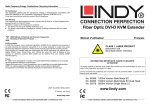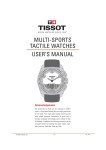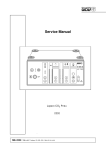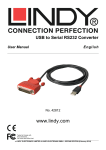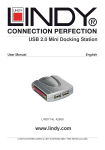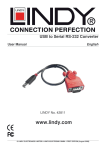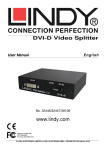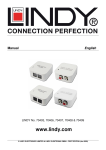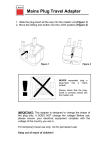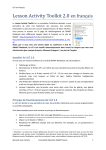Download USB Power Charger for 4 iPads www.lindy.com
Transcript
– USB Power Charger for 4 iPads User Manual Benutzerhandbuch Manuel d’utilisateur Manuale d’uso English Deutsch Français Italiano LINDY No. 73352 www.lindy.com © LINDY ELECTRONICS LIMITED & LINDY-ELEKTRONIK GMBH - FIRST EDITION (August 2012) User Guide Introduction Thank you for purchasing the LINDY 4 Port USB Power Charger, a compact solution for quickly charging up to 4 smart phones, tablets or other USB powered devices. A must have for the family home or when travelling with multiple devices. No longer worry about using or carrying a separate power adapter for each of your devices with this simple and lightweight charger. Features • • • • • • • Charges devices such as cameras, portable music players, smartphones and tablets Fast & efficient charging function Auto-detects fully charged devices and cuts power to the charging port Electrical current auto-adjusts up to 2.1A for each USB Port USB ports can simultaneously output 2.1A Low power design economises on power consumption Protection from power surges, short-circuits and overloads with over current, voltage & temperature protection (OCP, OVP & OTP) Technical Data Input voltage: Minimum 90V Nominal 110V - 230V Maximum 264V Input Frequency: Minimum 47 Hz Nominal 50 Hz - 60 Hz Maximum 63 Hz Output voltages and loads: SMPS load and regulation limits Signal Name Output +5V Min. 4.75 Voltage (Volts) Typ Max 5.0 5.25 Operating temperature ranges : 0°C~ 50°C Storage Temperature ranges : -20°C ~ 70°C For use indoors only and at low humidity. Tolerance +/-5% Current (A) I max. I min. 2.0 0.0 Benutzerhandbuch Einführung Vielen Dank für den Kauf des LINDY 4 Port USB High Power Ladegeräts, einer kompakten Lösung zum schnellen Aufladen von bis zu vier Smartphones, Tablets oder sogar vier iPads gleichzeitig über den USB-Port. Der Nutzen dieses Ladegeräts zeigt sich z.B. wenn die ganze Familie regelmäßig Smartphones, Tablets oder iPhone und iPad aufladen muss oder auch auf Reisen, wenn Sie nicht mehr für jedes Mobile Device ein extra Ladegerät mitnehmen müssen. Eigenschaften • Zum Laden von Smartphones, Tablets, iPad/iPhone/iPod, Digitalkameras, MP3-Playern usw. • Schnelle und effiziente Ladefunktion – lädt 4 iPads gleichzeitig • Erkennt automatisch wenn ein Device aufgeladen ist und unterbindet die Stromzufuhr am entsprechenden USB-Port • Automatische Anpassung der Stromstärke auf bis zu max. 2.1A für jeden USB Port • Ausgangsstrom pro USB Port (simultan) 2.1A • “Low Power Design” für sparsamen Stromverbrauch • Mit Überspannungsschutz, Überlastschutz, elektrischer Sicherung und Übertemperaturschutz Technische Daten Eingangsspannung: Minimum 90V Nominal 110V - 230V Maximum 264V Eingangsfrequenz: Minimum 47 Hz Nominal 50 Hz - 60 Hz Maximum 63 Hz Ausgangsspannung und -last: Last- und Regelbegrenzung des Schaltnetzteils: Nominal Ausgangsspannung +5V U min. 4.75 Spannung (Volt) typisch U max. 5.0 5.25 Betriebstemperatur : 0°C~ 50°C Lagertemperatur : -20°C ~ 70°C Nur in geschlossenen Räumen verwenden. Tolerance +/-5% Stromstärke (Ampere) I max. I min. 2.0 0.0 Manuel d´utilisateur Introduction Merci pour l’achat de ce chargeur USB 4 ports LINDY, une solution compacte, pour un chargement rapide de jusqu’à 4 smartphones, tablettes ou autres périphériques alimentés en USB. Indispensable pour un usage à domicile ou pendant vos déplacements. Ne vous souciez plus du chargement de vos périphériques avec de multiples chargeurs grâce à ce produit léger et simple d’utilisation. Caractéristiques • • • • • • • Charge les périphériques tels que caméras, smartphone, lecteurs MP3 et tablettes Chargement rapide et efficace Détection automatique de l’état de charge et coupure de l’alimentation du port correspondant Ajustement automatique de la puissance requise jusqu’à 2.1A pour chaque port USB Chaque port USB peut délivrer 2.1A simultanément Conçu pour une consommation économique Protéger contre les court-circuits et les sur-intensités, voltage et températures trop élevés (OCP,OVP et OTP) Données techniques Voltage en entrée : Minimum 90V Nomimal 110V-230V Maximum 264V Fréquences en entrée : Minimum 47Hz Nominal 50Hz – 60Hz Maximum 63Hz Tension de sortie et charge : Charge et limite de régulation de l’alimentation Unité de mesure Sortie +5V Voltage (Volts) Min. 4.75 Typ 5.0 Max 5.25 Températures d’utilisation : 0°C~ 50°C Températures de stockage : -20°C ~ 70°C Pour utilisation en milieu clos et non humides. Intensité (A) Tolérance +/-5% I max. 2.0 I min. 0.0 Manuale d´uso Introduzione Grazie per aver scelto l’alimentatore LINDY USB 4 porte, la soluzione compatta e pratica per caricare velocemente fino a 4 smartphone, tablet o altri dispositivi alimentabili via USB. Il componente ideale da tenere in casa e da portare con se per avere un solo alimentatore per caricare fino a quattro dispositivi. Caratteristiche • • • • • • • Ricarica dispositive come fotocamere, lettori mp3, smartphone, tablet, ecc.. Ricarica veloce ed efficiente Riconoscimento automatico di dispositivi carichi Regolazione automatica della corrente fino a 2.1A su ogni porta USB Ogno porta USB fornisce 2.1A Modalità power save automatica Protezione da cortocircuiti e sovratensioni, protezione su voltaggio & temperatura (OCP, OVP & OTP) Specifiche Tecniche Voltaggio in ingresso: Minimo 90V Nominale 110V - 230V Massimo 264V Frequenza in ingresso: Minima 47 Hz Nominale 50 Hz - 60 Hz Massima 63 Hz Voltaggi in uscita: SMPS e limiti Nome Uscita +5V Min. 4.75 Voltaggio (Volt) Tipo Max 5.0 5.25 Temperatura operativa: 0°C~ 50°C Temperatura di stoccaggio: -20°C ~ 70°C Per uso interno in ambienti con bassa umidità. Tolleranza +/-5% Corrente (A) I max. I min. 2.0 0.0 CE / FCC Statement / Recycling Information CE Certification This equipment complies with the requirements relating to electromagnetic compatibility, EN 55024 and EN55022 for ITE (Information Technolology Eqipment), EN61000-3-2/-3. FCC Warning This equipment has been tested and found to comply with the limits for a Class B digital device, pursuant to part 15 of the FCC Rules. Operation is subject to the following two conditions: 1. This device may not cause harmful interference, and 2. This device must accept any interference received, including interference that may cause undesired WEEE (Waste of Electrical and Electronic Equipment), Recycling of Electronic Products Europe, United Kingdom In 2006 the European Union introduced regulations (WEEE) for the collection and recycling of all waste electrical and electronic equipment. It is no longer allowable to simply throw away electrical and electronic equipment. Instead, these products must enter the recycling process. Each individual EU member state has implemented the WEEE regulations into national law in slightly different ways. Please follow your national law when you want to dispose of any electrical or electronic products. More details can be obtained from your national WEEE recycling agency. Germany / Deutschland Die Europäische Union hat mit der WEEE Direktive Regelungen für die Verschrottung und das Recycling von Elektro- und Elektronikprodukten geschaffen. Diese wurden im Elektro- und Elektronikgerätegesetz – ElektroG in deutsches Recht umgesetzt. Dieses Gesetz verbietet das Entsorgen von entsprechenden, auch alten, Elektro- und Elektronikgeräten über die Hausmülltonne! Diese Geräte müssen den lokalen Sammelsystemen bzw. örtlichen Sammelstellen zugeführt werden! Dort werden sie kostenlos entgegen genommen. Die Kosten für den weiteren Recyclingprozess übernimmt die Gesamtheit der Gerätehersteller. France En 2006, l'union Européenne a introduit la nouvelle réglementation (DEEE) pour le recyclage de tout équipement électrique et électronique. Chaque Etat membre de l’ Union Européenne a mis en application la nouvelle réglementation DEEE de manières légèrement différentes. Veuillez suivre le décret d’application correspondant à l’élimination des déchets électriques ou électroniques de votre pays. Italy Nel 2006 l’unione europea ha introdotto regolamentazioni (WEEE) per la raccolta e il riciclo di apparecchi elettrici ed elettronici. Non è più consentito semplicemente gettare queste apparecchiature, devono essere riciclate. Ogni stato membro dell’ EU ha tramutato le direttive WEEE in leggi statali in varie misure. Fare riferimento alle leggi del proprio Stato quando si dispone di un apparecchio elettrico o elettronico. Per ulteriori dettagli fare riferimento alla direttiva WEEE sul riciclaggio del proprio Stato. LINDY No. 73352 1st Edition August 2012 www.lindy.com







